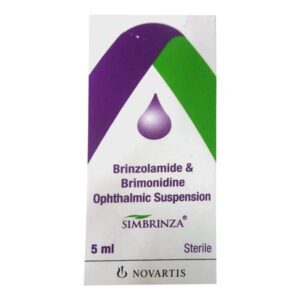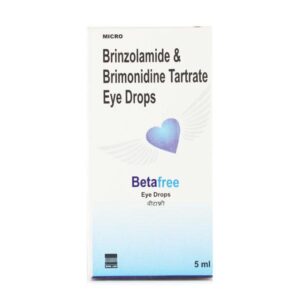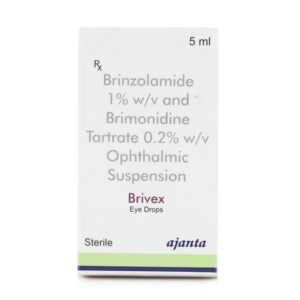BRIMONIDINE + BRINZOLAMIDE
Brimonidine: Brimonidine is a medication that is primarily used to lower intraocular pressure (IOP) in individuals with open-angle glaucoma or ocular hypertension. It belongs to a class of drugs known as alpha-2 adrenergic agonists.
The mechanism of action of brimonidine involves activation of alpha-2 receptors located in the ciliary body of the eye. Activation of these receptors leads to a decrease in the production of aqueous humor, the fluid that fills the front part of the eye. By reducing the production of aqueous humor, brimonidine helps to lower intraocular pressure, preventing damage to the optic nerve and preserving vision.
Brimonidine is typically administered as eye drops. The usual recommended dose is one drop in the affected eye(s) three times per day, with approximately 8 hours between each dose. It is important to follow the instructions provided by the healthcare professional and not exceed the prescribed dosage.
Like any medication, brimonidine may cause side effects. The most common side effects include burning or stinging sensation in the eye, redness of the eye, itching, dry mouth, and blurred vision. Other potential side effects may include dizziness, headache, fatigue, allergic reactions, changes in taste, and allergic conjunctivitis. It is advisable to contact a healthcare professional if any side effects become bothersome or persistent.
Brimonidine may also interact with certain medications, so it is important to inform the healthcare professional about all other medications being taken, including over-the-counter drugs and herbal supplements.
Overall, Brimonidine is an effective medication for reducing intraocular pressure in individuals with open-angle glaucoma or ocular hypertension. It is important to use this medication as directed and report any concerning side effects to a healthcare professional.
Brinzolamide: Brinzolamide is a medication used to treat high pressure inside the eye, a condition known as intraocular hypertension or open-angle glaucoma. It belongs to a class of drugs called carbonic anhydrase inhibitors.
The primary mechanism of action of brinzolamide is its inhibitory effect on the enzyme carbonic anhydrase, which reduces the production of aqueous humor in the eye. This helps to lower intraocular pressure, preventing damage to the optic nerve and preserving vision.
Brinzolamide is available as eye drops, which are typically applied directly to the affected eye(s). The recommended dose for adults is one drop in the affected eye(s) three times a day. However, the exact dosage may vary based on the individual’s specific condition and the doctor’s instructions. It is important to follow the prescribed dosage and directions given by the healthcare professional.
Like any medication, brinzolamide may cause side effects. Common side effects may include a bitter taste in the mouth, blurred vision, eye discomfort or irritation, stinging or burning sensation in the eyes, and temporary blurred vision after application. These side effects are usually mild and temporary.
Some less common but potentially serious side effects may include allergic reactions such as rash, itching, swelling, severe dizziness, difficulty breathing, and severe eye pain or redness. If any of these occur, it is essential to seek immediate medical attention.
It is important to inform the healthcare professional about any other medications being taken to avoid potential drug interactions. Brinzolamide may interact with certain medications, such as oral carbonic anhydrase inhibitors or high-dose aspirin, so it is vital to disclose all current medications to the healthcare provider.
Overall, brinzolamide is a medication that effectively lowers intraocular pressure in patients with high eye pressure and glaucoma. It should only be used under the guidance and prescription of a healthcare professional, who can monitor its effectiveness and manage any potential side effects.



